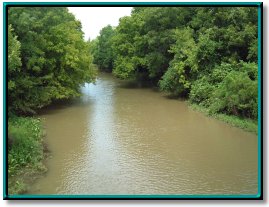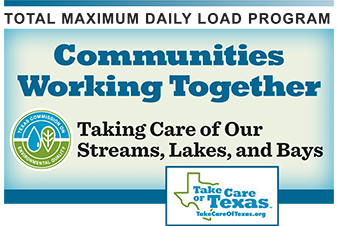Upper Oyster Creek
Counties: Fort Bend
Parameters: Bacteria, dissolved oxygen
River Basin: Brazos River
Segment: 1245
On this page:
- Background and Goals
- Get Involved
- Approved I-Plan
- Adopted TMDLs
- Reports and Other Documents
- Contact the TMDL Program
Background and Goals
Upper Oyster Creek is located within the Brazos River Basin, immediately southwest of Houston in northern Fort Bend County. Segment 1245, though named Upper Oyster Creek, also includes parts of Jones Creek, Oyster Creek, Flat Bank Creek, a diversion canal, and Steep Bank Creek. Upper Oyster Creek has been highly modified and serves as a portion of a water conveyance system for the Gulf Coast Water Authority.
Water quality testing found that bacteria levels in Upper Oyster Creek might pose a health risk for swimmers. Low dissolved oxygen concentrations in some areas of the creek indicate that conditions are not optimal for aquatic life.
The TMDL Program worked with area stakeholders to develop a plan to improve water quality in the creek. The goal of the project is to reduce bacteria concentrations to within acceptable risk levels for swimmers, and improve conditions to support a healthy aquatic community.
Get Involved
In all its projects, TCEQ gathers opinions and information from people who represent government, permitted facilities, agriculture, business, environmental, and community and private interests in the watershed. Staff from the Houston-Galveston Area Council (H-GAC) have been working with stakeholders to distribute information about this project and involve them in developing the I-Plan for watershed improvement.
All public meetings about this project are open to anyone interested. Watch for meeting announcements here.
Upper Oyster Creek stakeholder meeting
Stakeholders met with staff from TCEQ and H-GAC on Aug. 21, 2025 to discuss progress on the Upper Oyster Creek I-Plan.
Approved I-Plan
The commission approved this stakeholder-developed plan on Jan. 15, 2014.
- I-Plan for Two TMDLs for Dissolved Oxygen and One TMDL for Bacteria in Upper Oyster Creek
- Response to Public Comment on the I-Plan
Status of Activities
TCEQ provides opportunities for stakeholders to report on progress and changes in the watershed. Tracking of implementation progress allows stakeholders to evaluate actions taken, identify actions that may not be working, and make any changes as necessary.
Adopted TMDLs
Dissolved Oxygen TMDLs
On July 28, 2010, the commission adopted the TMDLs for dissolved oxygen. The EPA approved the TMDL on Sept. 21, 2010, at which time it became part of the state’s Water Quality Management Plan.
- Two TMDLs for Dissolved Oxygen in Upper Oyster Creek Segment: 1245; Assessment Units: 1245_02 and 1245_03
- Response to Public Comment on the TMDLs
Updates
Updates are made to account for changing conditions in the watershed, such as new or revised wasteload allocations, permits that have been canceled or have expired, or changed facility names. Updates are made via the state’s Water Quality Management Plan.
- October 2021, Appendix VI, pages 25-26
- July 2021, Appendixes IV, pages 18-23
- October 2020, Appendix IV, pages 23-24
- October 2018, Appendix V, pages 18-19
- April 2016, Appendix VII, pages 22-23
- April 2015, Appendix VII, pages 35-36
- October 2013, Appendix V, p. 50
- January 2012, Appendix VIII, pages 36-37
WQMP updates may be viewed in person at the TCEQ Library, Building A, 12100 Park 35 Circle, Austin, Texas. Electronic versions of updates published from 2014 through 2020 are available on the Texas State Library and Archives Commission website .
Bacteria TMDL
The commission adopted this TMDL for bacteria on Aug. 8, 2007. The EPA approved the TMDL on Sept. 28, 2007, at which time the TMDLs became part of the state’s Water Quality Management Plan.
-
One TMDL for Bacteria in Upper Oyster Creek
Segment 1245 - Response to Public Comment on the Bacteria TMDL
Updates
Updates are made to account for changing conditions in the watershed, such as new or revised wasteload allocations, permits that have been canceled or have expired, or changed facility names.
- October 2021, Appendix V, pages 27-29
- October 2020, Appendix III, page 22
- October 2018, Appendix IV, pages 16-17
- April 2016, Appendix VI, pages 19-21
- April 2015, Appendix VI, pages 33-34
- October 2013, Appendix IV, p. 48
- January 2012, Appendix VII, pages 34-35
- July 2011, pages 10 & 30
- April 2010, pages 9 & 18
- January 2009, pages 10-12
- July 2008, pages 7-9
- April 2008, pages 12-14
WQMP updates may be viewed in person at the TCEQ Library, Building A, 12100 Park 35 Circle, Austin, Texas. Electronic versions of updates published from 2014 through 2020 are available on the Texas State Library and Archives Commission website .
For WQMP updates prior to 2014, use the TRAIL Search engine as outlined below. The main search box on the page will only conduct a simple search with no exclusionary parameters and should not be used.
- First, limit your search to TCEQ only. Do this via the advanced search feature on the left of the page. To limit a search to TCEQ content, enter www.tceq.texas.gov or www.tceq.state.tx.us into the “From the Host” search box.
- Refine your search to narrow down results. The other search boxes on the left of the page allow for search terms to be included, excluded, or used in an exact phrase search. Date ranges can be used as well.
Reports and Other Documents
Dissolved Oxygen
 Model files (ZIP) for dissolved oxygen in the upper reach (right-click to download the ZIP archive)
Model files (ZIP) for dissolved oxygen in the upper reach (right-click to download the ZIP archive)- Addendum to Upper Oyster Creek Dissolved Oxygen TMDL Technical Support Document (Oct. 14, 2008)
- Upper Oyster Creek Dissolved Oxygen TMDL Technical Support Document (February 2008)
- Upper Oyster Creek Dissolved Oxygen Assessment (Updated April 6, 2007)
Bacteria
- Technical Support Document: Upper Oyster Creek Bacteria TMDL
- Technical Support Document (November 2006)
- Appendix A: Fecal Coliform and E. coli Data
- Appendix B: Photographs of Upper Oyster Creek BST Stations
- Appendix C: Ribotyping Protocol
- Appendix D: Fecal Sampling Collection Summary Table
- Appendix E: BST E. coli Quantification Data
- Appendix F: Ribotyping Results for E. coli
- Appendix G: Detailed E. coli Source Characterization by Station
- Appendix H: Model Predicted Streamflow and Measured E. coli Data Used in Developing Load Duration Curves
- Final Monitoring Report for Bacterial Source Tracking
Contact the TMDL Program
Please e-mail tmdl@tceq.texas.gov, and mention the Upper Oyster Creek project in the subject. Or call us at 512-239-6682.





 Back to top
Back to top